Also, I have been getting a lot of emails this week asking for advice on how to upholster different pieces. In all sincerity, I wish I had the time to help with all of your projects, but unfortunately, there is just not enough time in the day. I hope you're able to figure out the projects on your own. Otherwise, I suggest consulting a professional or a friend with upholstery experience.
Alright! So, now that the chair has been stripped of it's old fabric, cleaned and repainted, it's time to staple the new fabric on.
I forgot to say earlier that when you're pulling apart the chair, be careful to not rip any of the old fabric. Use a sharpie to mark what pieces go where and use these as templates for cutting your new fabric.

When you're cutting your new fabric, pay special attention to the pattern. Line things up both vertically and horizontally so that the pattern is perfectly centered.

Like I mentioned earlier, if the insides of a piece are still in good shape, I like to save the money and hassle and just reuse. I was able to reuse all of my burlap and batting here, which was great. However, I did run into a problem with the amount of staples I was using.

There were so many layers of fabric to staple down to a very small lip on the frame, that I was starting to completely destroy the integrity of the wood (not good). The great news about upholstery project goof ups is they are almost always completely reversible. Put a staple in the wrong place? No problem. Pull it out and try again! The only reason upholstery should be considered a more advanced craft project, is it takes some ability to think outside the box a little. If you have some experience with diy projects and sewing, you can usually figure out solutions to the inevitable little problems that come up.
Like I mentioned yesterday, I had hoped that buying a new electric staple gun that used smaller, rounded staples would fix my problem. But the staple gun was really weak and was more frustrating than anything. So my mom and I did some outside the box thinking and decided take some steps that would reduce the number of staple layers from four to two.
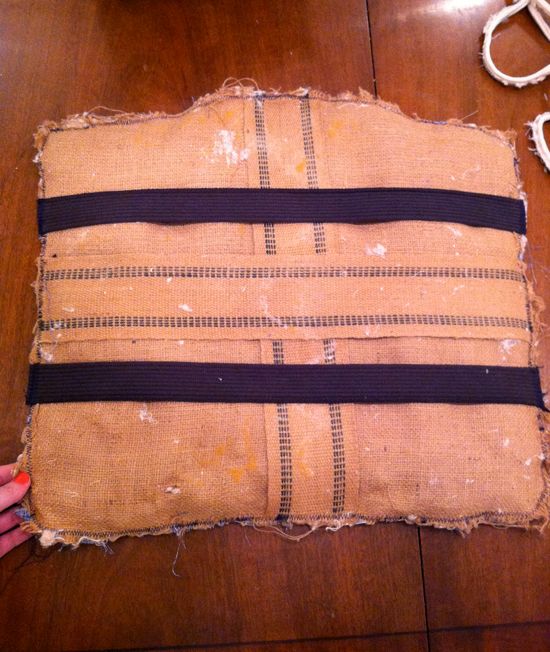
We used a big zigzag stitch on my sewing machine (the best model ever made
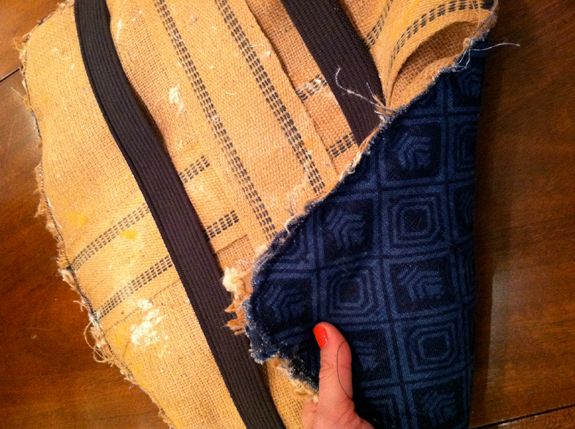
I should also note here that I added those two pieces of brown webbing. I don't know if they were necessary, but I thought it might help give a little more support on the back (and it did!!).

Once the support parts of the back were all sewn together for reinforcing, we stapled that piece in place. Remember, the key to a successful reupholstery job is to reference all those photos you took of the chair in it's original state and as you were pulling it apart. Wherever possible, reconstruct the piece just as it was put together the first time. Don't reinvent the wheel here!
If you should get anything out of this post, this is it. Here is how I approach stapling the fabric in place for the perfect smoothness and tautness. I pretty much use this method on every surface I've ever upholstered:
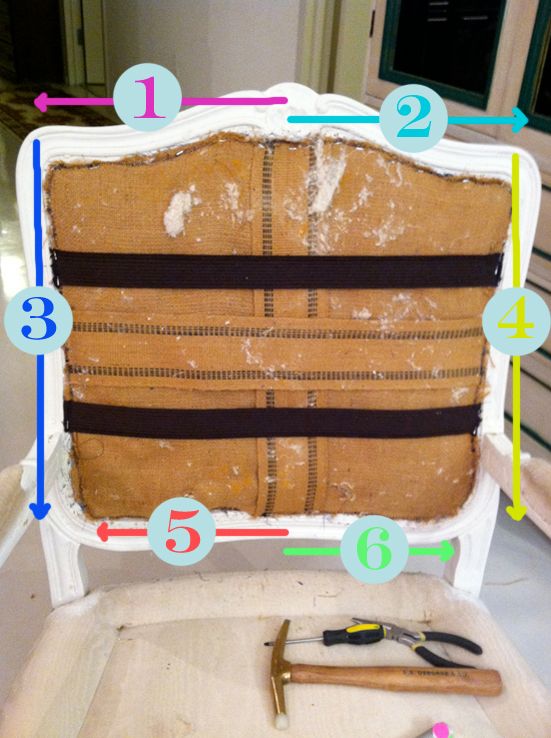
1. Put one staple in the center top of your project, hold the left side out very tightly and run a line of staples out to the edge of the top. I usually leave a one inch space between each staple at first, and then I come back and fill in the spaces with a staple. Be really thoughtful about each staple placement though. It's easy to get sloppy and just put in a ton of staples, but that just ends up tearing up the frame and the fabric.
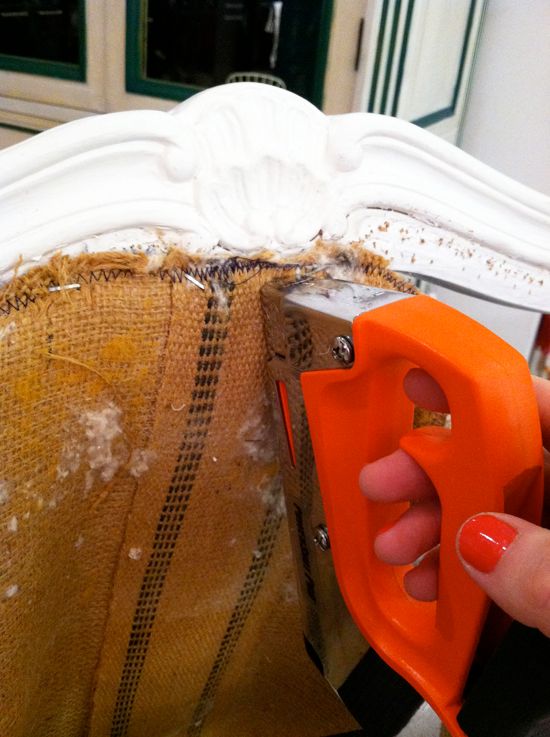
I LOVE this little tack hammer I got from CS Osbourne. It's perfect for quickly and quietly going over the staples and getting them completely flush with the frame. A regular hammer can tear up the wood and a mallet is usually too big, so these are great. I tack in the staples after every line of stapling, just to make sure the fabric stays where I placed it the first time.
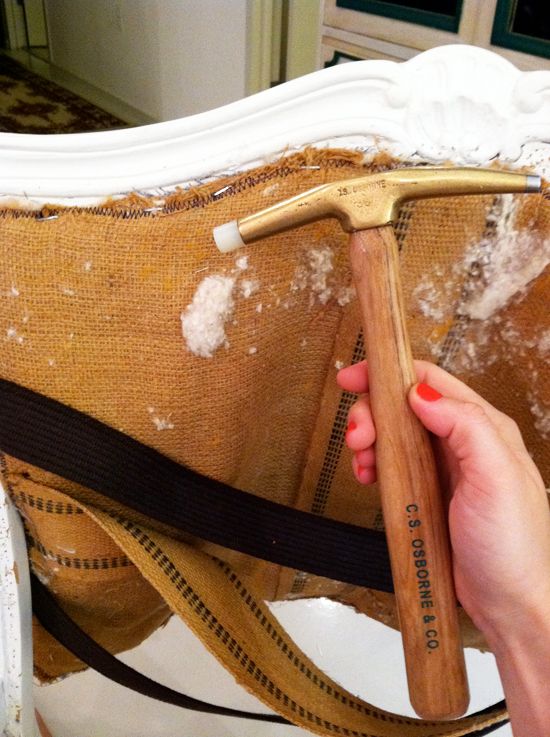

6. From the center again, work out to to the right. Your helper might have to use a pair of pliers for this last part. Again, you really want a tight pull here.
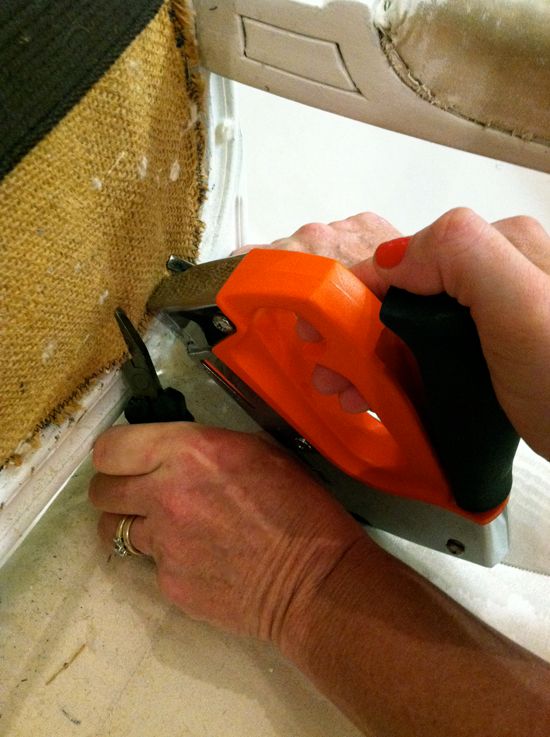
And those are the basic steps to stapling on the back piece. It's really not that hard.
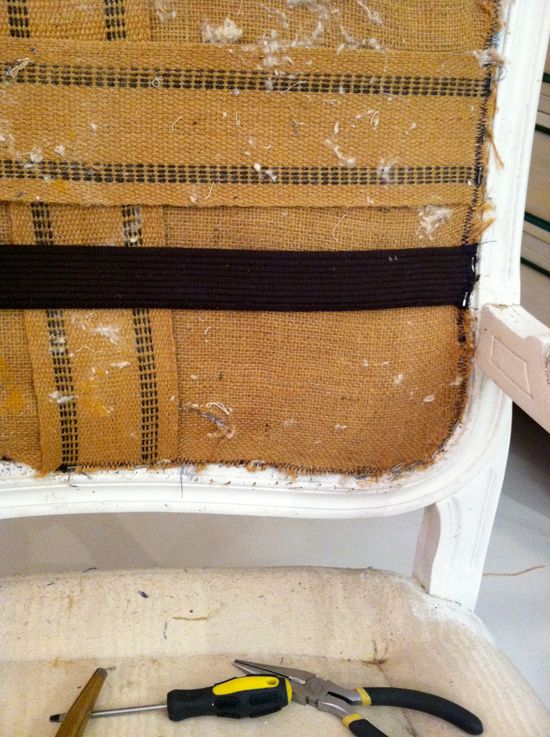
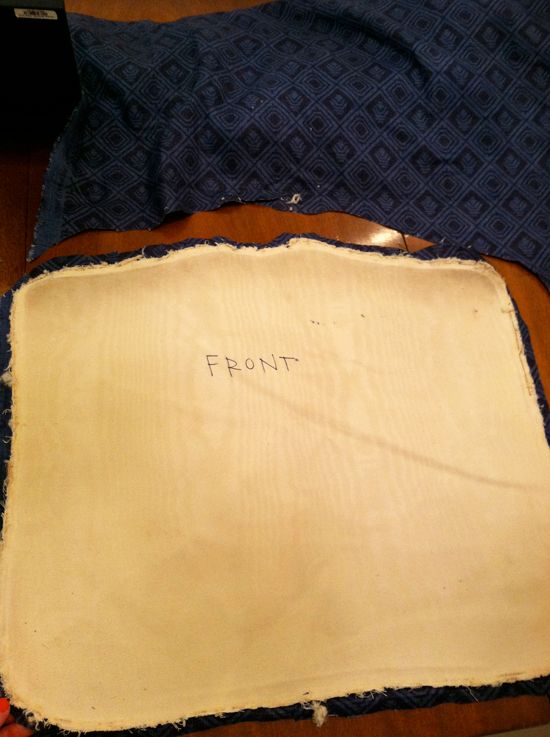
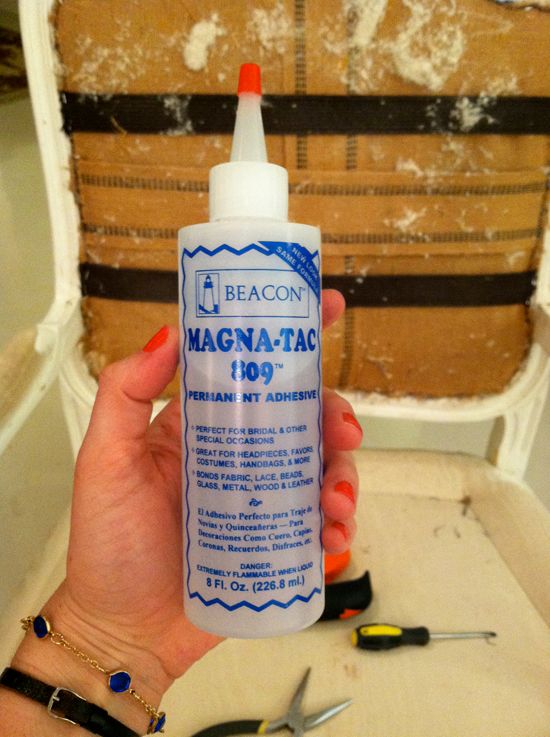

Another favorite adhesive is Pro Stick spray glue. It is cheap and good. I spray this on the webbing layer and also on the second layer of foam and batting again to help everything stay put while I got the staples in place. You really don't want things shifting around when you're trying to match a pattern exactly.

After the Magna-tac and the spray glue, the next layer was pretty well stuck in place before I started stapling.
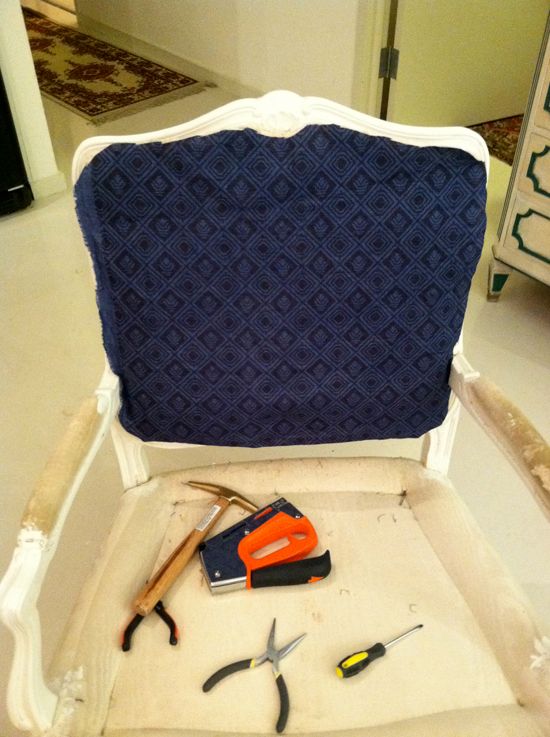

If you should get anything out of this post, this is it. Here is how I approach stapling the fabric in place for the perfect smoothness and tautness. I pretty much use this method on every surface I've ever upholstered:

1. Put one staple in the center top of your project, hold the left side out very tightly and run a line of staples out to the edge of the top. I usually leave a one inch space between each staple at first, and then I come back and fill in the spaces with a staple. Be really thoughtful about each staple placement though. It's easy to get sloppy and just put in a ton of staples, but that just ends up tearing up the frame and the fabric.

I LOVE this little tack hammer I got from CS Osbourne. It's perfect for quickly and quietly going over the staples and getting them completely flush with the frame. A regular hammer can tear up the wood and a mallet is usually too big, so these are great. I tack in the staples after every line of stapling, just to make sure the fabric stays where I placed it the first time.

2. Start in the center again and hold the right side and staple moving to the right. Tack in staples.
3. Now that the top piece has been centered and securely tacked in place, you have a great foundation. The next steps are all about pulling and getting the fabric smooth and very tight. Pulling down on the left side, I staple the left edge next, from top to bottom and then tack all those in.
4. Pulling down and to the right, I staple down the right hand side and tack in the staples. Your fabric should be really tight at this point.
5. The last line along the bottom is probably where you're going to need an extra set of hands. Have your helper pull down really hard and then staple in your center. Work out to the left with your helper moving and pulling down with you.
3. Now that the top piece has been centered and securely tacked in place, you have a great foundation. The next steps are all about pulling and getting the fabric smooth and very tight. Pulling down on the left side, I staple the left edge next, from top to bottom and then tack all those in.
4. Pulling down and to the right, I staple down the right hand side and tack in the staples. Your fabric should be really tight at this point.
5. The last line along the bottom is probably where you're going to need an extra set of hands. Have your helper pull down really hard and then staple in your center. Work out to the left with your helper moving and pulling down with you.

6. From the center again, work out to to the right. Your helper might have to use a pair of pliers for this last part. Again, you really want a tight pull here.

And those are the basic steps to stapling on the back piece. It's really not that hard.

Once the back piece and the webbing were in place, I cut out the fabric for the front of the chair back, again using the old fabric template (don't forget to line up the pattern!!). This time though, I gave myself about an inch of extra fabric to work with.

Okay, now for a little bit about upholstery adhesives. I have historically been a big fan of E-6000 epoxy. It works wells and has a strong hold. But I don't love how long it takes to dry (I get impatient holding and waiting) and once the first half of the metal tube is gone, I find it's really hard to squeeze out the epoxy.
I'm sure you know I am a HUGE fan of Fabri-Tac . Recently I started using this glue (also made by Beacon Adhesives) called Magna-tac
. Recently I started using this glue (also made by Beacon Adhesives) called Magna-tac . It is seriously amazing. It's similar to Fabri-tac, but even better. It bonds fabric, wood, metal - just about anything.
. It is seriously amazing. It's similar to Fabri-tac, but even better. It bonds fabric, wood, metal - just about anything.
I'm sure you know I am a HUGE fan of Fabri-Tac

I used it a lot in this project to sort of reinforce pieces. I ran a line around the border of the back piece to help the next layer of foam and batting to stay put while I stapled.

Another favorite adhesive is Pro Stick spray glue. It is cheap and good. I spray this on the webbing layer and also on the second layer of foam and batting again to help everything stay put while I got the staples in place. You really don't want things shifting around when you're trying to match a pattern exactly.

After the Magna-tac and the spray glue, the next layer was pretty well stuck in place before I started stapling.

I followed the same stapling pattern for the second layer on the chair back, starting at the top in the center.
You can see below that I rolled under the edge of the fabric (that's why I cut it a little big). This helps to both keep the edges clean and not frayed, but it really helps to reinforce and strengthen the edges.
So again, to recap, just roll under the edge about half an inch, center your pattern and place your first staple in the center. Continue rolling under, pulling tight and stapling and tacking in the same pattern outlined above.
You can see below that I rolled under the edge of the fabric (that's why I cut it a little big). This helps to both keep the edges clean and not frayed, but it really helps to reinforce and strengthen the edges.
So again, to recap, just roll under the edge about half an inch, center your pattern and place your first staple in the center. Continue rolling under, pulling tight and stapling and tacking in the same pattern outlined above.

The arms are easy. Just cut out an oval a couple inches bigger on all sides. Pay close attention to to pattern though!



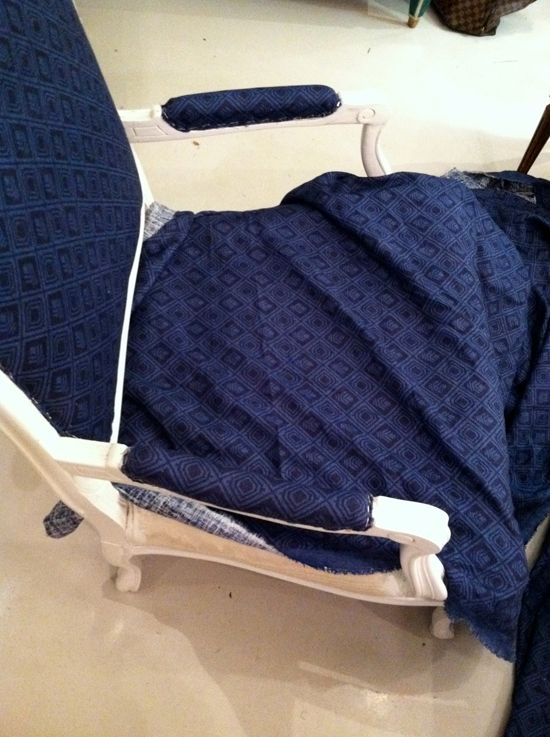
Follow those same stapling patterns. Top (or front in this case) center and working out to the edges, pulling tight the whole way. (see how the pattern lines up in the center here?)
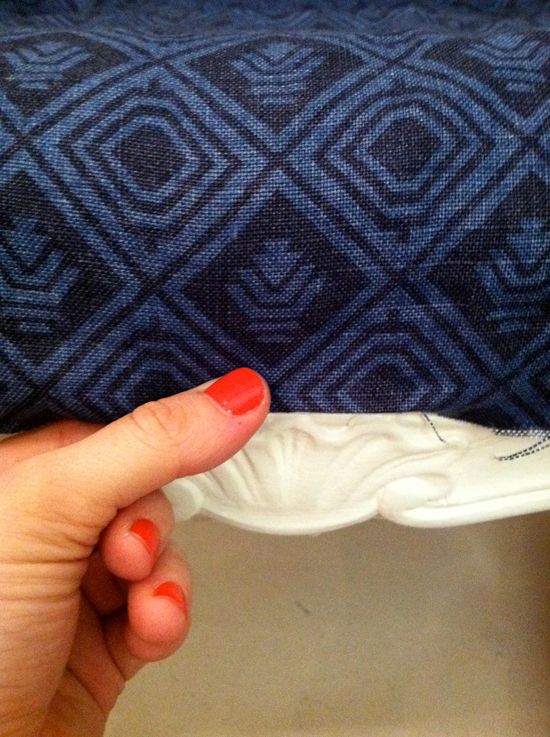
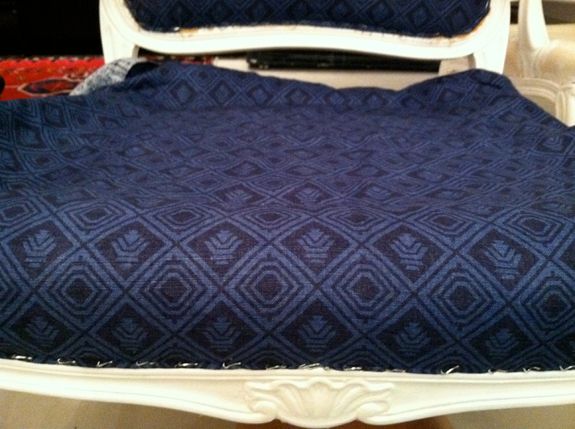
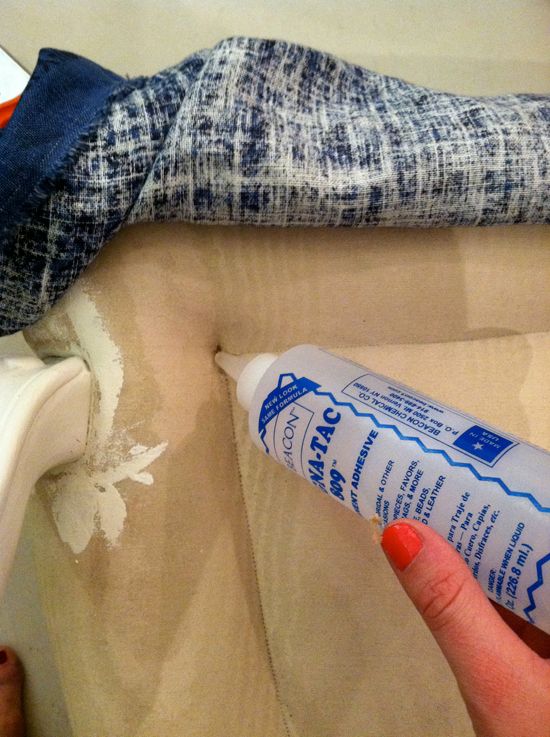
You can see how the fabric slopes in here and now fits inside the seams.
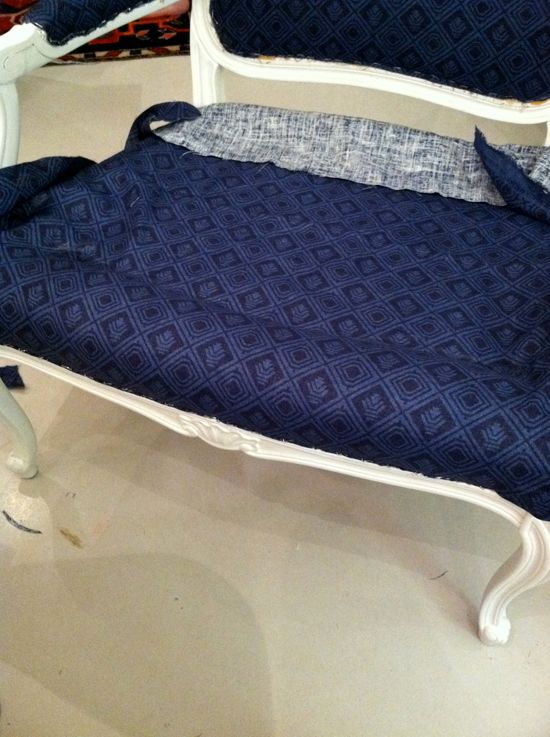
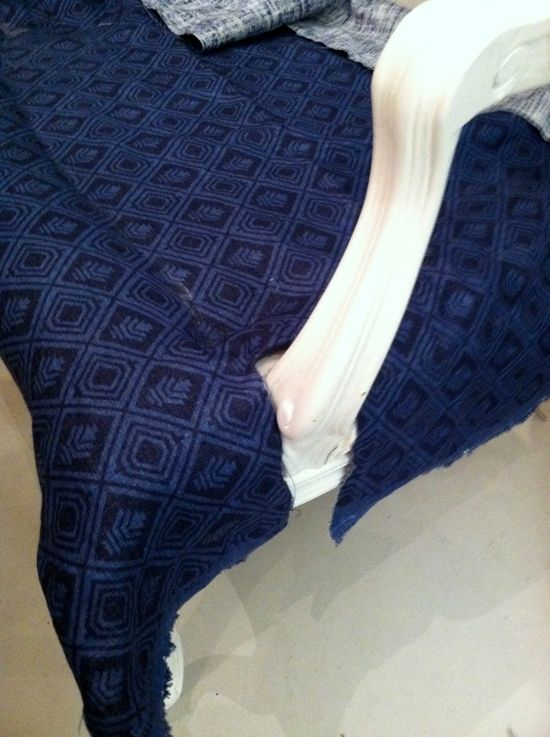


Then just like wrapping a present. fold in both corners and staple in again.
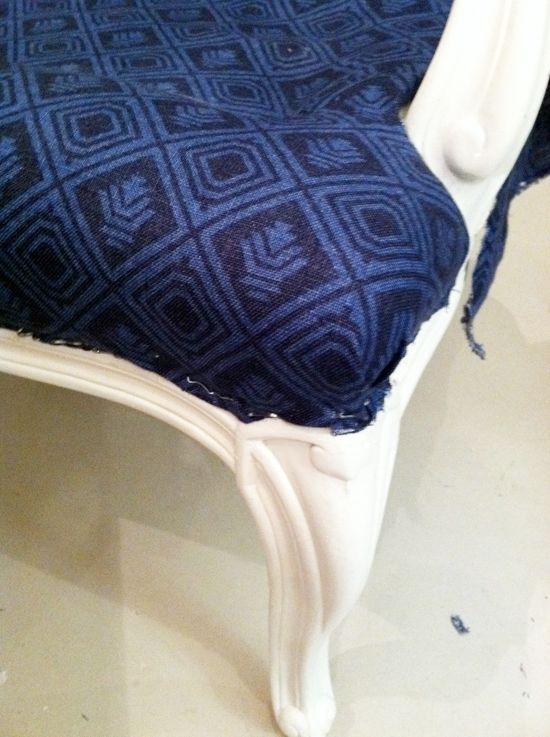
I finished up the front first because I had to glue down the other seam parts. Then I worked my way around to the sides and the back, cutting around the legs, rolling in, pulling tight, stapling and tacking.
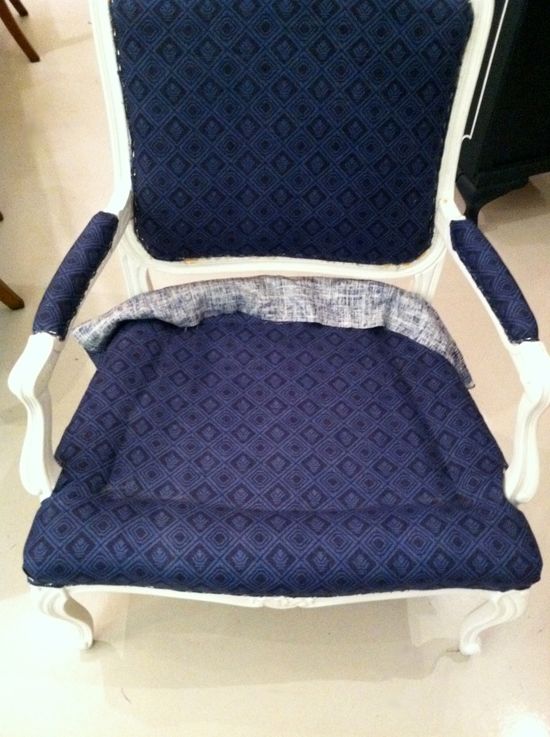

It's really not as hard as it feels. It's one of those projects where you can figure it out best when you're just doing it. It will make sense as you're pulling and stapling.

Next steps: how to make piping and apply it to the chair and how to make the cushion!


Follow the same stapling pattern rules above. Start at the center top and work you way around, pulling down the whole time. Get that fabric taut!

I was careful to run the pattern along the curve here (not straight) so that I could see the same design all along the top of the arm.
Once the staples are tacked down, I used a small scissor to snip off the excess fabric.
Once the staples are tacked down, I used a small scissor to snip off the excess fabric.

Next up is the bottom of the chair - the part that goes under the cushion. I draped some fabric over that part, carefully matching up the pattern, and cutting it a little longer than need, again so I could roll under the edges.

Follow those same stapling patterns. Top (or front in this case) center and working out to the edges, pulling tight the whole way. (see how the pattern lines up in the center here?)

Tack those staples in place and keep moving around and pulling tight! Leave the corners alone for now though until all the straight lines are done.

Here was another one of those outside-the-box thinking moments. The seat bottom was sewn in to place (one of the reasons I didn't pull off the old fabric) and it sort of sloped down, so that if I just stapled and pulled tight there would be a space between the chair and the new fabric. I needed to connect the new fabric with the old seams. After I stapled down the front, I glued a line along the old seam and pulled the fabric down tightly into the seam area. Later I hand tacked the corners.

You can see how the fabric slopes in here and now fits inside the seams.

The legs seem like they would be sort of scary, but they are easy too. Just cut out a notch in the fabric, but again, just leave enough extra fabric to roll in the edges. No need to staple the fabric around the inside of the actual leg. Just do the bottom row like normal.
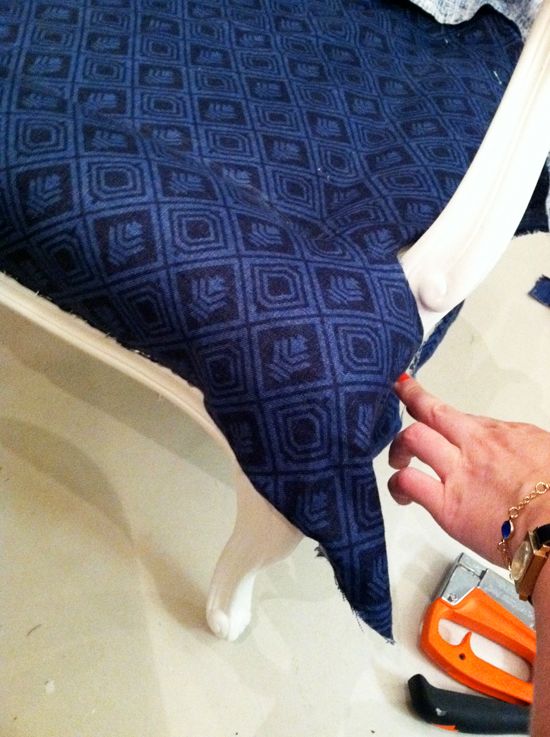
The rolled in edges will look clean and by pulling tight down on the bottom, there will be no lifting around the leg area. If you want to extra support you can run a line of magna-tac around the leg. And don't worry too much about exactness here. The welting will help cover up the gaps.

The rolled in edges will look clean and by pulling tight down on the bottom, there will be no lifting around the leg area. If you want to extra support you can run a line of magna-tac around the leg. And don't worry too much about exactness here. The welting will help cover up the gaps.

Once all the straight lines around the bottom have been stapled and tacked down, it's time to do the corners. Again, reference the photos you took before. Here's what the old corners looked like:

For a corner like this, just pull down the middle and put one staple in.

Then just like wrapping a present. fold in both corners and staple in again.

I finished up the front first because I had to glue down the other seam parts. Then I worked my way around to the sides and the back, cutting around the legs, rolling in, pulling tight, stapling and tacking.

And then the stapling part was done!

It's really not as hard as it feels. It's one of those projects where you can figure it out best when you're just doing it. It will make sense as you're pulling and stapling.

Next steps: how to make piping and apply it to the chair and how to make the cushion!

